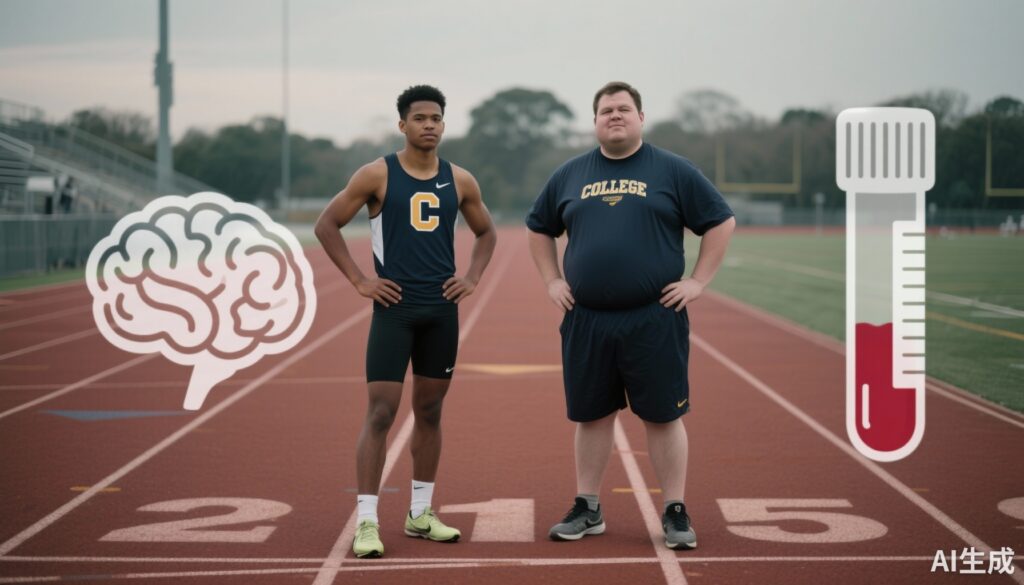Highlight
– In the CARE Consortium cohort, athletes and cadets with obese BMI (≥30) reported fewer baseline symptoms but exhibited greater symptom burden after concussion and worse objective cognitive performance across recovery.
– Individuals with obese BMI had higher circulating CRP and IL‑1RA at every sampled time point and transiently higher IL‑6, IL‑8, and VEGF after injury, suggesting an amplified systemic inflammatory milieu that persists through return-to-play.
– These data indicate obese BMI modifies both clinical recovery and peripheral inflammatory response after sport‑related concussion (SRC), with implications for risk stratification and targeted recovery strategies.
Background
Sport-related concussion (SRC) is a common traumatic brain injury with variable recovery trajectories. Most young athletes recover within weeks, but a meaningful minority experience persistent symptoms and neurocognitive deficits. Identifying pre-injury factors that influence outcome is essential for prognostication and individualized management.
Obesity is highly prevalent worldwide and is characterized by chronic, low-grade systemic inflammation. Adipose tissue secretes cytokines and adipokines that raise baseline inflammatory mediators (for example, C‑reactive protein [CRP] and interleukin‑6 [IL‑6]) and alter immune responses. Chronic inflammation is hypothesized to prime the central nervous system for exaggerated or prolonged neuroinflammation after head injury, potentially worsening functional outcomes. The CARE (Concussion Assessment, Research and Education) Consortium provides a large, prospective dataset to evaluate how obese body mass index (BMI ≥30.0) affects both clinical metrics and circulating inflammatory biomarkers after SRC.
Study design
Cohort and setting
The study is a subanalysis of the NCAA‑DoD CARE Consortium, a multicenter, prospective longitudinal cohort of collegiate student‑athletes and military cadets from 30 academic institutions. Participants completed baseline assessments prior to athletic seasons. Concussed participants were followed with repeated clinical evaluations and blood sampling at standardized intervals.
Participants and groups
Concussed participants (n = 3002) were stratified by BMI into obese (BMI ≥30.0) and non‑obese groups. A representative subset (n = 547) underwent inflammatory biomarker assays at serial time points: baseline, immediately postinjury, 24 hours postinjury, when asymptomatic, and 7 days after unrestricted return-to-play (uRTP).
Outcomes
Primary clinical outcomes included symptom count and severity, domain scores on neurocognitive testing (verbal memory, visual memory, visual motor speed), and psychological symptom scores. Biomarker outcomes included plasma concentrations of CRP, interleukin‑1 receptor antagonist (IL‑1RA), IL‑6, IL‑8, and vascular endothelial growth factor (VEGF) measured longitudinally.
Key findings
Baseline symptomatology and paradoxical presentation
At baseline (preseason), participants with obese BMI reported fewer symptoms, lower overall symptom severity, and lower psychological symptom scores than those without obesity (p < 0.0001–0.004). This counterintuitive finding may reflect underreporting, different symptom perception, or psychosocial factors influencing baseline symptom endorsement.
Postinjury clinical trajectory
After concussion, participants with obese BMI exhibited higher symptom scores than non‑obese peers (p < 0.0001). On objective testing, obese participants demonstrated worse performance in verbal memory, visual memory, and visual motor speed at all postinjury time points (p < 0.0001). These differences persisted through clearance for unrestricted return-to-play, suggesting a consistent adverse effect of obesity on neurocognitive recovery after SRC.
Inflammatory biomarker profile
Across all sampled time points, obese participants had higher circulating CRP and IL‑1RA compared with non‑obese participants (p < 0.05), indicating a sustained, elevated inflammatory baseline and postinjury state.
Temporal differences were observed for other cytokines: IL‑6 was higher in obese participants from 24 hours postinjury through after uRTP; IL‑8 was elevated from postinjury to 24 hours postinjury; VEGF was higher at the immediate postinjury time point. These time‑dependent elevations suggest both acute and sustained inflammatory signaling differences in obese athletes following concussion.
Effect sizes and statistical significance
The study reports statistically robust differences (many with p-values <0.0001) between BMI groups for symptom and cognitive outcomes, as well as for key biomarkers (CRP and IL‑1RA) across time points. Full effect sizes, confidence intervals, and models adjusting for covariates (age, sex, sport, prior concussion history) are reported in the original CARE Consortium paper (Eagle et al., Sports Med 2025).
Expert commentary and interpretation
Biological plausibility
The observed pattern—elevated baseline inflammatory mediators in obese individuals and greater postinjury cognitive dysfunction—fits a biologically plausible model. Chronic peripheral inflammation associated with obesity could (1) prime microglia and other innate immune cells in the brain to mount exaggerated responses after biomechanical injury, (2) impair blood–brain barrier integrity or recovery pathways, and (3) interfere with neuroplastic processes necessary for cognitive recovery. Elevated IL‑1RA, a counter‑regulatory marker, may reflect chronic activation of interleukin‑1 signaling pathways.
Clinical implications
These findings raise the possibility that BMI is a clinically useful risk stratifier for concussion recovery. Clinicians should be aware that athletes with obese BMI may underreport baseline symptoms yet be at greater risk for worse objective cognitive outcomes and prolonged inflammatory activation after SRC. This may warrant closer monitoring, extended return‑to‑play timelines, and tailored rehabilitation strategies that account for metabolic and inflammatory comorbidities.
Limitations and alternative explanations
Important limitations must be considered. BMI is an imperfect proxy for adiposity and metabolic health; measures such as waist circumference, body composition, or metabolic biomarkers (insulin resistance) may better capture relevant risk. Residual confounding is possible—factors associated with obesity (sleep apnea, depression, cardiovascular fitness, pharmacotherapy) could contribute to observed differences. Baseline underreporting among obese participants complicates interpretation of symptom trajectories.
Biomarker interpretation is constrained by peripheral sampling: circulating cytokines do not directly equate to central nervous system inflammation, and the timing of sampling relative to pathophysiological cascades matters. Finally, the cohort comprises collegiate athletes and military cadets—a relatively young and active population—so generalizability to community athletes or older adults is uncertain.
Research and mechanistic questions
Key next steps include (1) using more precise adiposity and metabolic measures to disentangle obesity from metabolic dysfunction, (2) longitudinal multimodal assessments that integrate neuroimaging, CSF or advanced peripheral biomarkers, and functional outcomes, and (3) interventional trials testing whether metabolic or anti‑inflammatory strategies (e.g., weight loss, exercise prescription, sleep optimization) modify recovery after SRC in obese individuals.
Conclusion
The CARE Consortium analysis indicates obese BMI modifies both the clinical expression and peripheral inflammatory response to sport‑related concussion in collegiate athletes and military cadets. Obese participants showed fewer baseline symptoms but worse postinjury symptom burden and neurocognitive performance, alongside a persistently elevated inflammatory profile (notably CRP and IL‑1RA) and transient increases in IL‑6, IL‑8, and VEGF after injury.
Clinicians should consider BMI and related metabolic health when assessing concussion risk and recovery planning. Future studies should refine risk stratification using body composition and metabolic markers and evaluate targeted interventions to reduce inflammation and improve neurologic recovery in obese athletes.
Funding and clinicaltrials.gov
The CARE Consortium is supported by the National Collegiate Athletic Association (NCAA) and the US Department of Defense (DoD). The primary study report (Eagle et al., Sports Med 2025) describes funding and disclosures. A clinicaltrials.gov identifier is not specified in the primary citation provided here.
References
1. Eagle SR, Huber D, McCrea M, Okonkwo DO, Harezlak J, McAllister T, Pasquina P, Broglio S, Meier TB; CARE Consortium Investigators. Effect of Obese Body Mass Index on Clinical Outcomes and Inflammatory Blood Biomarkers following Sport-Related Concussion in Collegiate Athletes and Military Cadets: Findings from the NCAA-DoD CARE Consortium. Sports Med. 2025 Nov;55(11):2891-2903. doi: 10.1007/s40279-025-02257-8 IF: 9.4 Q1 . PMID: 40560505 IF: 9.4 Q1 .
2. Hotamisligil GS. Inflammation and metabolic disorders. Nature. 2006 Dec 14;444(7121):860-7. doi: 10.1038/nature05485 .
3. Ng M, Fleming T, Robinson M, et al. Global, regional, and national prevalence of overweight and obesity in children and adults during 1980–2013: a systematic analysis. Lancet. 2014;384(9945):766–781. doi:10.1016/S0140-6736(14)60460-8 .


